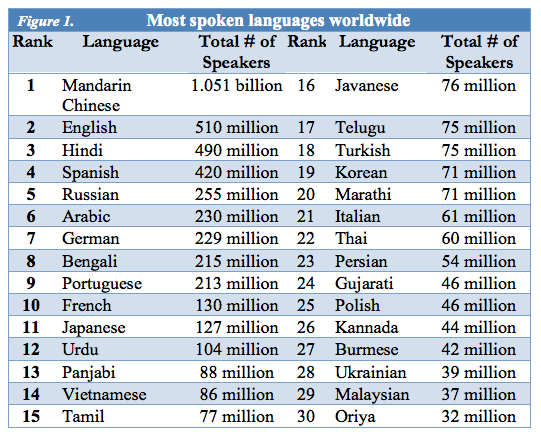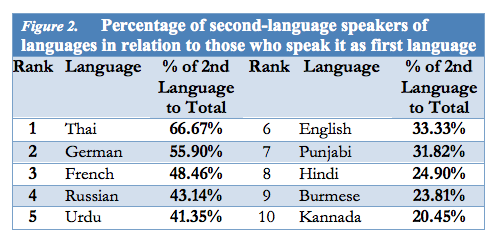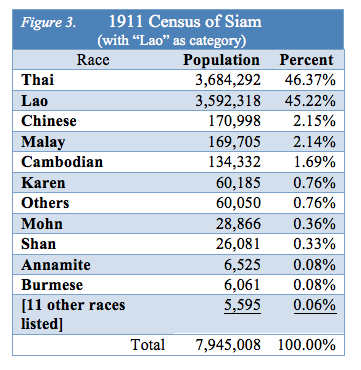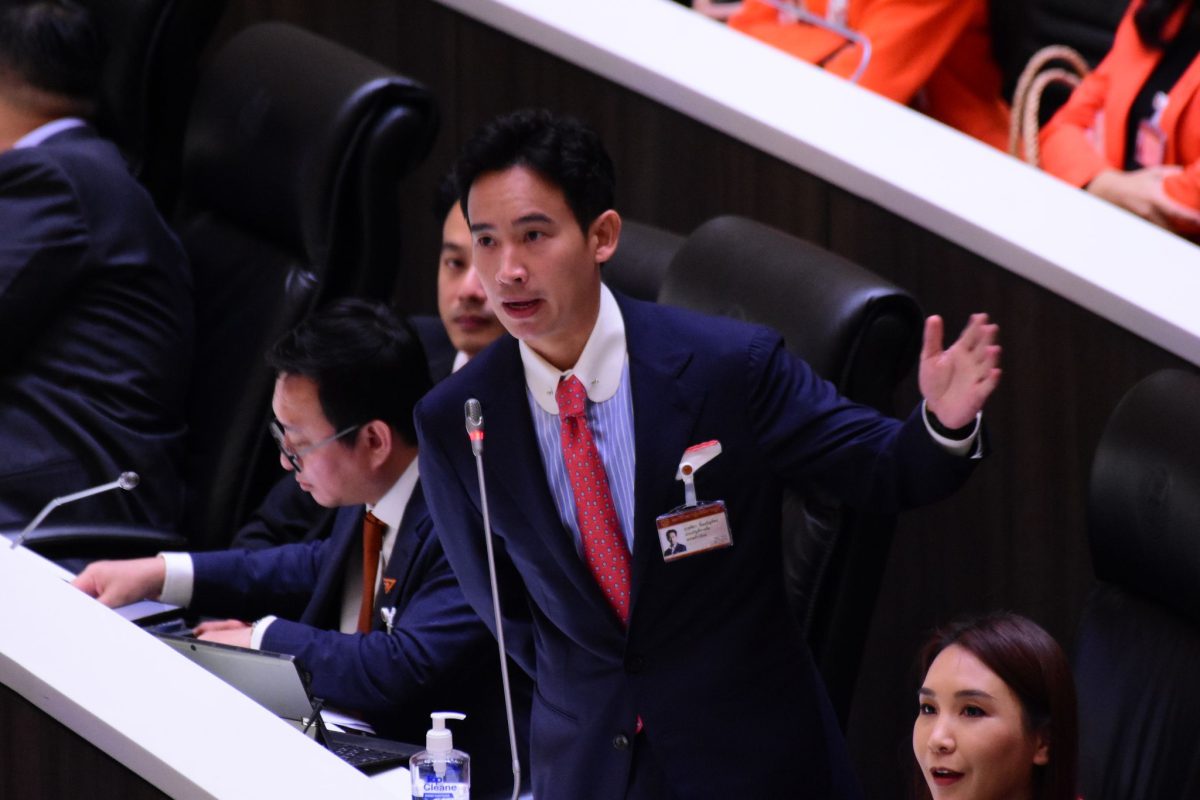If Ethnologue says 67% of Thai speakers speak it as a second language, what language are those people speaking as their first language? And what does this mean for Thailand’s divided politics?
GUEST EDITORIAL by Karl Victor
The organization Ethnologue has a peculiar statistic in its 2015 report on Thailand. The Thai language comes in 22nd in the highest number speakers (Figure 1), depending on the rendering. This is not surprising, but the figure showing that there are twice as many second-language Thai speakers than first-language Thai speakers is.
In fact, compared to the other major languages in the world, Thai is in a class by itself, with 67% of Thai speakers speaking it as a second language. The next closest is German with 56%, followed by French at 48%, Russian at 43%, and Urdu at 41% (Figure 2).

Source: Adapted from Vistawide Languages & Cultures
Broadly speaking, we might the ratio between those who speak a language as their first and second languages, according to three categories:
1) Coterminous formations
2) Imperialism and lingua franca
3) Multi-ethnic empires
Examples of the first type are Japanese, Polish, Korean, and Italian. These languages are spoken almost exclusively as a first language and the percentage of those speaking it as a second language is less than one per cent: the language virtually does not extend beyond its geographical borders.
An example of the second type is French, which became a lingua franca for the nineteenth century through imperialism and its influence in law. English is another, with a third of all English speakers using it as a second language. Its spread can be attributed to English and American conquest, both in terms of colonialism and cultural production. German is notable as more than half of those speaking it speak it as a second language.
A third type results from pre-modern empires established over what we would call now multi-ethnic polities. Russian is a good example, as there are second-language Russian speakers strewn across the former Russian Empire and then USSR. It is an empire whose borders disintegrated and ended up merely as “Great Russia” or “Russia Proper.”
 Siam/Thailand stands out within Southeast Asia. Avoiding direct colonialization allowed the traditional elite to retain their power unhindered. The ability of the Bangkok elite to adapt the European concepts of race and the mechanism of the census has masked non-Thai ethnicities to create the impression that the vast majority of the population was safely and clearly of one race.
Siam/Thailand stands out within Southeast Asia. Avoiding direct colonialization allowed the traditional elite to retain their power unhindered. The ability of the Bangkok elite to adapt the European concepts of race and the mechanism of the census has masked non-Thai ethnicities to create the impression that the vast majority of the population was safely and clearly of one race.
Siam/Thailand imposed Thai as both official language and language of instruction. The highly centralized state made Bangkok the focal point of the culture and national life. Thai-ification has always been hierarchical. Other Tai-speaking people in the kingdom were and are looked on with a certain level of suspicion. They could study upward, go to the best universities in Bangkok, attempt to hide their accent and background, profess enduring love for the monarchy, and even, sometimes, take high positions in government—but yet at the end of the day, they were something less than the pure Thais of Siam Proper.
Despite the resurgence of values of hierarchy since the new rise of the royalists from 2005 on, there is a belief held by many Thais that if they are part of the same race, then all within that race should be treated with respect.
Thai-ification worked for a century, and there have been just enough families in the past that have benefitted from the present system that potential non-Thai ethnic identities have remained dormant. However, there is within it a promise that all Thais will benefit more equally, that their votes will be held in respect, and that there will or should be a reversal of the kind of centralization that benefits those outside of Bangkok and nearby provinces. If fulfilled under Thai-ness, then the tension of a submerged, latent ethnic conflict subsides.
 As to the question of what language those people speaking Thai as a second language are speaking as their first language, the answer is “Lao.” Ever since the first census in Siam in 1904, there has been an attempt by the Thai state to deny that the people in the North and Northeast are Lao.
As to the question of what language those people speaking Thai as a second language are speaking as their first language, the answer is “Lao.” Ever since the first census in Siam in 1904, there has been an attempt by the Thai state to deny that the people in the North and Northeast are Lao.
It is understandable in a way because had “Lao” been a racial category in that 1911 census, there would have been no majority “race” in the country. Instead, the population would have been officially divided into two very large groupings—the Thai and the Lao (Figure 3). There would not have been a “minority problem.” If claiming Lao ancestry were to suddenly become popular, the Thai state’s survival, the status quo would itself be in question.
Speakers of Lao in the North and Northeast have seen the prime minister they elected into office dismissed by the courts twice, overthrown in a coup twice, and election results nullified twice. Such antics, if continued, could provoke resistance and rebellion along age-old and not-completely-forgotten ethnic lines.




